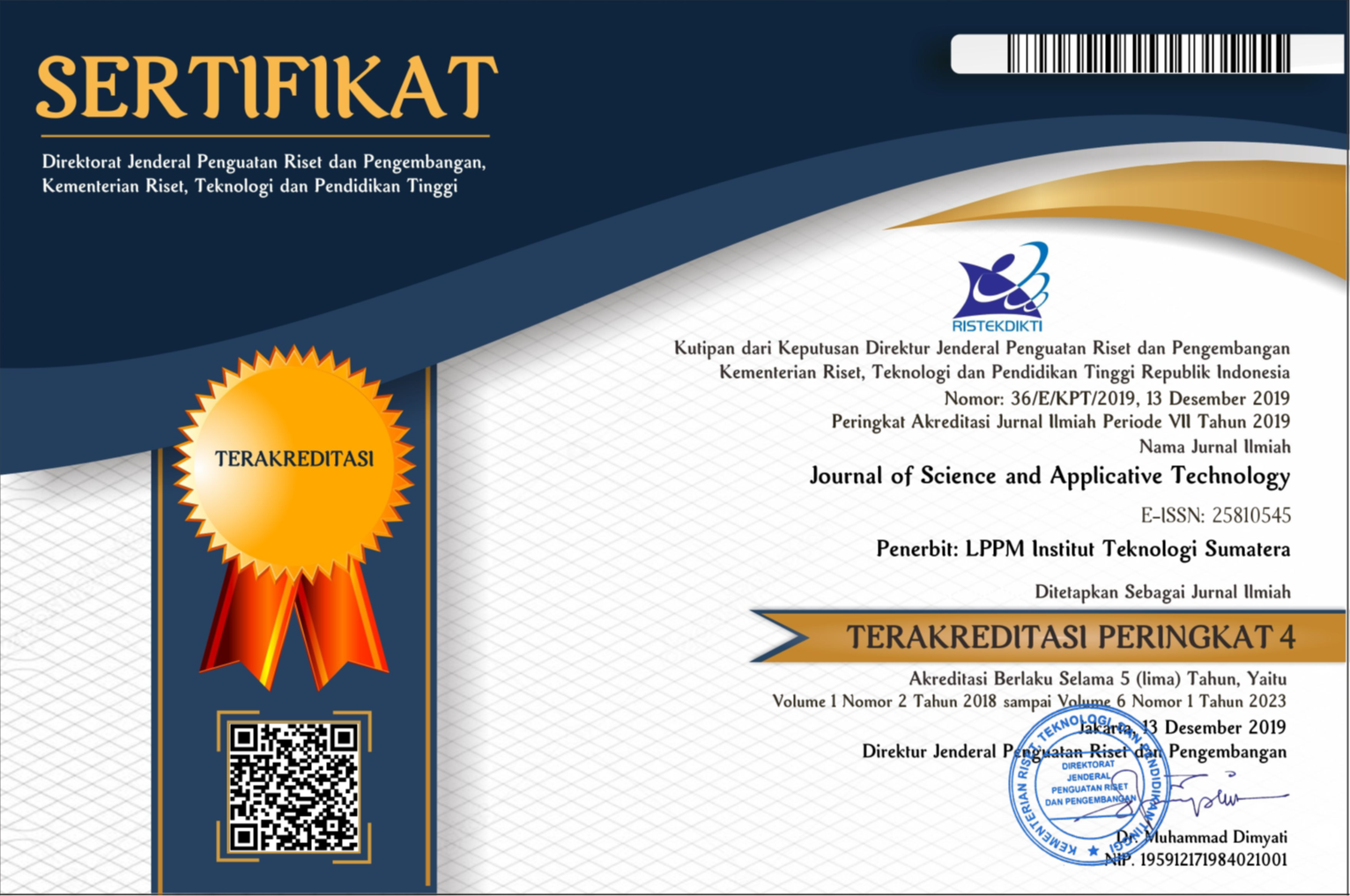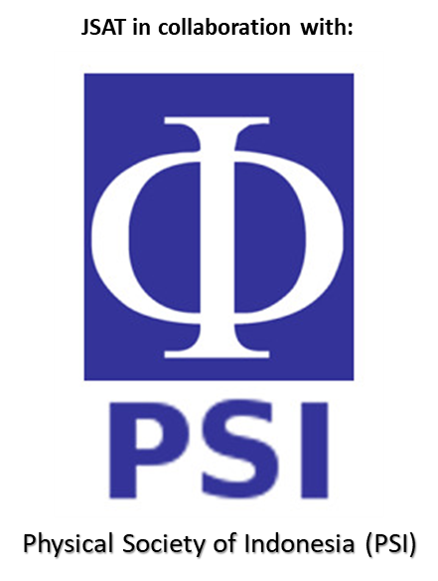Optimasi Sintesis Methyl Cellulose (MC) dari Biji Salak (Salacca edulis Reinw) Pondoh Super
Abstract
Snake fruit (Salacca zalacca) is one of the typical fruits from Indonesia. Pondoh is one of the snake fruit species largely found in Yogyakarta. The kernels of snake fruit are wastes, but contains a lot of cellulose. Cellulose can be processed into methyl cellulose And be used as food additive. This study aimed to understand the optimized the optimizing synthesis of methyl cellulose through the concentration of NaOH, dimethyl sulfate and reaction temperature. The study was conducted by extracting cellulose using 4 % NaOH concentrations. Dehemicellulose and bleaching were done to dilute hemicellulose and lignin. The optimization of methyl cellulose was done using Response Surface Methodology with various concentrations of NaOH (10, 15, 20, 25, 30%), dimethyl sulfate (2, 3, 4, 5, 6 ml), and temperature (45, 50, 55, 60, 65°C). NaOH could change cellulose crystalline region and formed Na-cellulose. Dimethyl sulfate can be acted as substitution agent, while temperature controlling plays role to obtain appropriate conditions for reaction. The results showed that the use of NaOH concentration, dimethyl sulfate and temperature affected the degree of substitution, OHC and lightness. The addition of NaOH and dimethyl sulfate in producing methyl cellulose had more effect on the increasing of degree of substitution than temperature treatment. The optimum condition of methyl cellulose were 0.91% NaOH; 3.52 ml of dimethyl sulfate, at 46.51°C temperature.
Downloads
References
[2] W. Arnasis, “Agribisnis Komoditas Salak. Bumi Aksaraâ€, Jakarta, 1996.
[3] Supriyadi; Suhardi; M. Suzuki; K. Yoshida; T. Muto; A. Fujita; dan N. Watanabe, “Changes in the Volatile Compounds and in the Chemical and Physical Properties of Snake Fruit (Salaca edulis Reinw) Cv. Pondoh During Maturationâ€, Journal of Agricultural Food Chemistry, vol. 50, no. 26, pp. 7627-7633, 2002.
[4] B.L. Browning, “Methods of Wood Chemistry Vol. 11.†Interscience Publishers A Division of John Wiley an Sons, New York, 1967.
[5] G. S. Hutomo, “Sintesis dan Karakteristik Turunan Selulosa dari POD Husk Kakao (Theobroma cacao L.)â€, Desertasi, Program Pascasarjana Universitas Gadjah Mada, Yogyakarta, 2012.
[6] R. J. Fassenden dan J. S. Fessenden, “Organic Chemistry, Fifth Editionâ€, Delta State University, Cleveland, 1999.
[7] V. Pushpamalar; S. J. Langford; M. Ahmad dan Y. Y. Lim, “Optimization of Reaction Conditions for Preparing Carboxymethyl Cellulose from Sago Wasteâ€, Carbohydrate Polymers, vol.64, pp. 312-318, 2006.
[8] R.G. P Viera; G. R. Filho; R. M. N Assungcao; C. Dasmeireles; J. G. Viera dan G.S. De Oliveira, “Syntesis and Characterization of Methyl Cellulose from Sugar Cane Bagase Cellulose†Carbohydrate Polymers. vol. 67, pp. 182-189, 2007.
[9] J. G. Vieira; G. C. Oliviera; G. R. Filho; R. M. N. de Assuncao; C. S. Meireles; D. A. Cerqueira; W. G. Silva dan L. A. C. Motta, “Production, Characterization and Evaluation of Methyl Cellulose from Sugar Cane Bagasse for Application as Viscosity Anhancing Admixture for Cement Based Materialoâ€. Carbohydrate Polymers. vol. 78, pp. 779-783, 2009.
[10] R. Sun, dan S. Hughes, “Fractional Extraction and Physico-Chemical Characterization of Hemicellulose and Cellulose from Sugar Beet Pulpâ€, Journal of Carbohydrate Polymers. vol. 36, pp. 293-299, 1998.
[11] B. Adiseno, “Sintesis dan Karakterisasi Sodium Karboksimetil Selulosa dari Tandan Kosong Kelapa Sawit serta Aplikasinya Sebagai Penstabil Emulsi Santan Kelapaâ€, Tesis, Program Pascasarjana Universitas Gadjah Mada, 2008.
[12] M. K. Ferdiansyah, “Isolasi Selulosa dan Sintesis CMC dari Pelepah Kelapa Sawitâ€, Tesis, Program Pasca Sarjana Universitas Gadjah Mada, Yogyakarta, 2013.
[13] M.P. Adinugraha, D. W. Marseno, Haryadi. “Syntesis and Characterization of Sodium Carboxymethylsellulose from Cavendish Banana Pseudo Stem (Musa cavendishii LAMBERT)â€, Carbohydrate Polymers, vol. 62, pp. 164-169, 2005.
[14] A. S. Pujokaroni, “Sintesis dan Karakterisasi Sodium Karboksimetil Selulosa dari Sabut Kelapa Sawitâ€, Tesis, Fakultas Teknologi Pertanian Universitas Gadjah Mada, 2014.
[15] L. Rahmidar, A. Wahidiniawati, dan T. Sudiarti, “Pembuatan dan Karaterisasi Metil Selulosa dari Bonggol dan Kulit Nanas, (Ananas comosus)â€, Jurnal Pendidikan dan Ilmu Kimia, vol. 2, no. 1, pp. 88-96, 2018.
[16] N. R. Nurjannah, T. Sudiarti, dan L. Rahmidar, “Sintesis dan Karaterisasu Selulosa Termetilasi sebagai Biokomposit Hidrogelâ€, al-Kimiya. vol. 7, no. 1, pp. 19-27, 2020.
[17] R. L. Oliviera, J. G. Vieira, H. S. Barud, R. M. N. Assuncao, G. R. Filho, Sidney J. L. Reibero, Y. Messadeqq, “Synthesis and Characterization of Methyl Cellulose Produced from Bacterial Cellulose under Heterogeneus Conditionâ€, Journal of the Brazilian Chemical Society, vol. 26, no. 9, pp. 1861-1870, 2015.
[18] D. Ye dan X. Farriol, “Preparation and Characterization of Methyl Cellulosa from Some Annual Plant Pulpsâ€, Industrial Crops and Products, vol. 26, pp. 54-62, 2007.
[19] C. M Rosell; E. Santos dan C. Collas, “Psysico-chemical Propertiesof Commercial Fibers from Different Sources A Comparative Approachâ€, Food Research International, vol. 42, pp. 176-184, 2009.
[20] C. F Chau; K. Cheung dan Y. S. Wong, “Functional Properties of Protein Concentrates from Three Chinese Indigenous Legume Seedsâ€, Journal of Agricultural Food Chemistry, vol. 45, no. 7, pp. 2500-2503, 1997.
[21] G. R. Filho; R. M. N. De Assuncao; J. G. Viera; C. D. S. Meireles; D. A. Cerquera; H. D. S. Barud; S. J. L. Ribeno, dan Y. Messaddeq, “Characterization of Methycellulose Producted from Sugar Cane Baggase Cellulose: Crstallinity and Thermal Propertiesâ€, Polymer Degradation and Stability, vol. 92, pp. 205-210, 2007
[22] G. Mann, J. Kunze; Loth, dan H.P. Fink, “Cellulose Ethers with A Block-Like Distribution of the Substituents by Structure-Selective Derivatization of Cellulose†Polymers. vol. 39, no. 14, pp. 3155-3165, 1998.
[23] S. Anggrahini.; D. W. Marseno; A. Setiyoko; A. Wahyuningtyas, “Carboxymethyl Celulose (CMC) From Snake Fruit (Salaca edulis Reinw) Kernel of “Pondoh Superâ€: Synthesis and Characterizationâ€, Indonesian Food and Nutrition Progress. vol. 14, no. 2, 2017.
[24] P. L. Nasatto, F. Pignon., J. L. M. Silveira, M. E. R. Duarte, M. Noseda, M. Rinaudo, “Methylcellulose, a Cellulose Derivative with Original Physical Properties and Extended Applicationsâ€. Polymers, vol. 7, no. 5, pp. 777-803, 2015.
Copyright (c) 2021 Journal of Science and Applicative Technology

This work is licensed under a Creative Commons Attribution-NonCommercial 4.0 International License.
All the content on Journal of Science and Applicative Technology (JSAT) may be used under the terms of the Creative Commons Attribution-NonCommercial 4.0 International License.
You are free to:
- Share - copy and redistribute the material in any medium or format
- Adapt - remix, transform, and build upon the material
Under the following terms:
- Attribution - You must give appropriate credit, provide a link to the license, and indicate if changes were made. You may do so in any reasonable manner, but not in any way that suggests the licensor endorses you or your use.
- NonCommercial - You may not use the material for commercial purposes.
- No additional restrictions - You may not apply legal terms or technological measures that legally restrict others from doing anything the license permits.





















